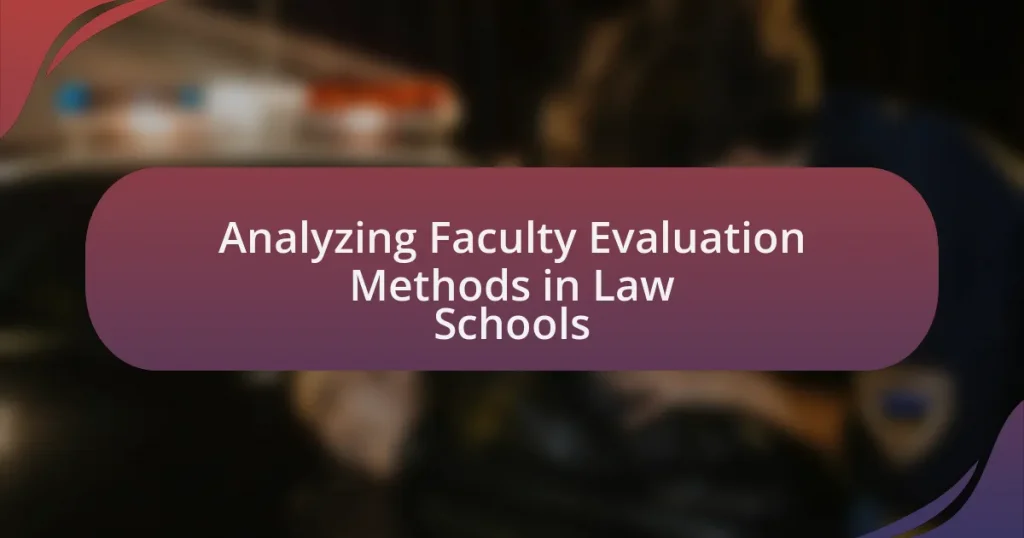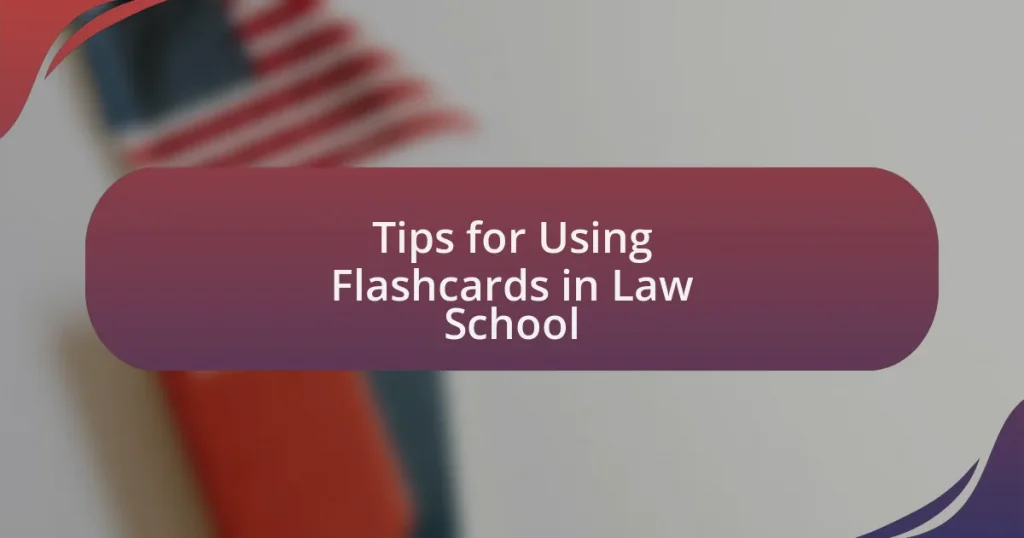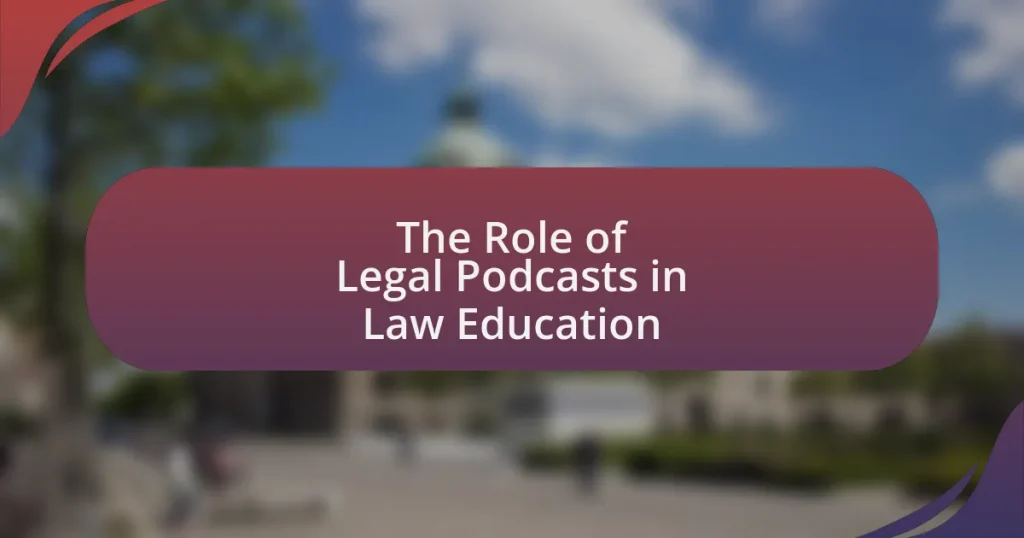The article analyzes faculty evaluation methods in law schools, focusing on peer evaluations, student evaluations, self-assessments, and administrative reviews. It highlights how these methods impact faculty performance by providing structured feedback that enhances teaching effectiveness and scholarly productivity. The article also discusses the criteria used in evaluations, variations across different law schools, and the importance of these evaluations in maintaining academic standards and improving student outcomes. Additionally, it addresses challenges such as bias in evaluations and offers best practices for implementing fair and effective evaluation processes.
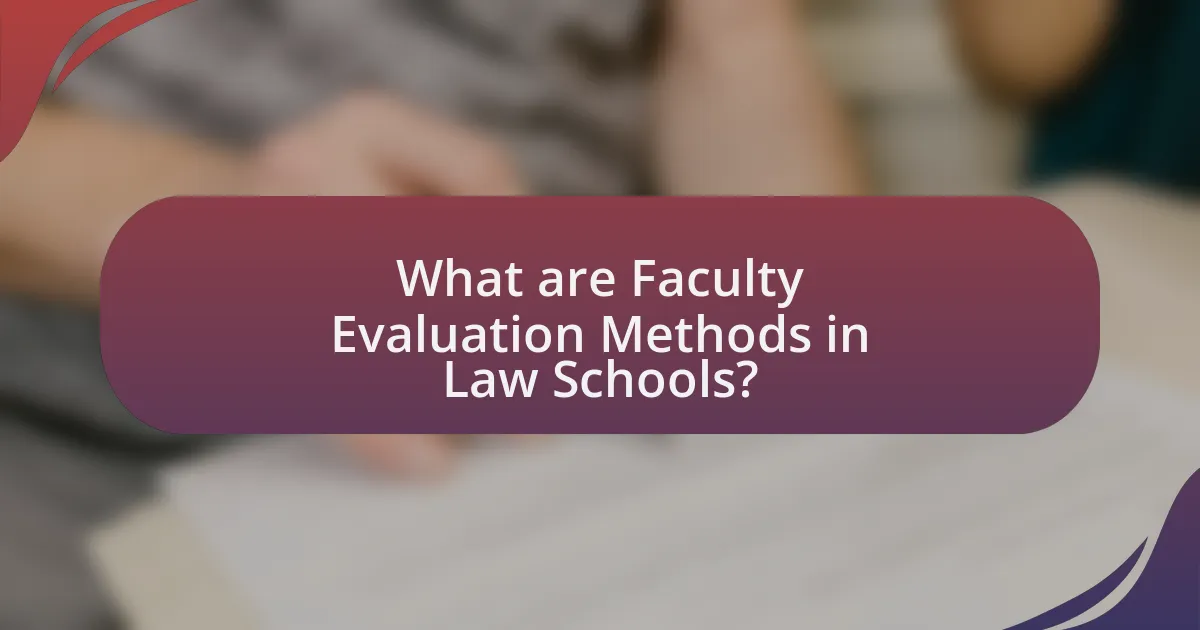
What are Faculty Evaluation Methods in Law Schools?
Faculty evaluation methods in law schools primarily include peer evaluations, student evaluations, self-assessments, and administrative reviews. Peer evaluations involve faculty members assessing each other’s teaching effectiveness and scholarly contributions, providing a professional perspective on performance. Student evaluations gather feedback from students regarding teaching quality, course content, and overall learning experience, often influencing faculty assessments. Self-assessments require faculty to reflect on their teaching practices, research output, and service contributions, promoting personal accountability. Administrative reviews involve evaluations conducted by department heads or deans, focusing on faculty performance in alignment with institutional goals. These methods collectively aim to enhance teaching quality, research productivity, and service to the academic community.
How do these evaluation methods impact faculty performance?
Evaluation methods significantly impact faculty performance by providing structured feedback that can enhance teaching effectiveness and scholarly productivity. For instance, peer evaluations and student feedback can identify strengths and areas for improvement, leading to targeted professional development. Research indicates that faculty who receive regular evaluations are more likely to engage in reflective practices, which can improve their instructional strategies and student engagement. A study published in the Journal of Higher Education found that faculty members who participated in comprehensive evaluation processes reported a 20% increase in their teaching effectiveness over a three-year period. This demonstrates that systematic evaluation methods not only hold faculty accountable but also foster an environment of continuous improvement, ultimately benefiting both educators and students.
What criteria are used in faculty evaluations?
Faculty evaluations typically use criteria such as teaching effectiveness, research productivity, service contributions, and professional development. Teaching effectiveness is assessed through student evaluations, peer reviews, and course materials. Research productivity is measured by publications, citations, and grants received. Service contributions include participation in committees, community engagement, and mentorship roles. Professional development encompasses ongoing education and involvement in academic conferences. These criteria are essential for ensuring a comprehensive evaluation of faculty performance in law schools.
How do evaluation methods vary across different law schools?
Evaluation methods vary across different law schools primarily in their reliance on traditional exams, practical assessments, and peer evaluations. For instance, some law schools emphasize final exams as the primary means of assessment, while others incorporate continuous assessment through class participation, written assignments, and practical simulations. Additionally, certain institutions may utilize peer evaluations to assess faculty performance, contrasting with others that rely solely on student evaluations. This diversity in evaluation methods reflects the varying educational philosophies and curricular structures among law schools, as evidenced by studies indicating that schools with a focus on experiential learning often adopt more varied assessment strategies compared to those that prioritize theoretical knowledge.
Why is faculty evaluation important in legal education?
Faculty evaluation is important in legal education because it ensures the quality of teaching and scholarship, which directly impacts student learning outcomes. Effective faculty evaluation processes provide feedback that helps educators improve their instructional methods and curriculum design, fostering a more engaging and effective learning environment. Research indicates that institutions with robust faculty evaluation systems report higher student satisfaction and academic performance, demonstrating the correlation between faculty effectiveness and student success in legal education.
What role does faculty evaluation play in maintaining academic standards?
Faculty evaluation plays a critical role in maintaining academic standards by systematically assessing teaching effectiveness, research contributions, and service commitments of faculty members. This evaluation process ensures that faculty meet established benchmarks for quality, which directly influences the educational experience of students and the overall reputation of the institution. Research indicates that institutions with robust faculty evaluation systems report higher student satisfaction and improved academic outcomes, as these evaluations help identify areas for professional development and accountability. For instance, a study published in the Journal of Higher Education found that regular faculty assessments correlate with enhanced teaching practices and curriculum development, thereby reinforcing academic integrity and excellence.
How does faculty evaluation influence student outcomes?
Faculty evaluation significantly influences student outcomes by directly impacting teaching quality and course effectiveness. Research indicates that faculty who receive constructive evaluations tend to improve their instructional methods, leading to enhanced student engagement and comprehension. For instance, a study published in the Journal of Higher Education found that faculty members who participated in peer evaluations reported a 20% increase in student satisfaction and performance metrics. This correlation suggests that effective faculty evaluation not only fosters professional development but also creates a more conducive learning environment, ultimately benefiting student academic success.
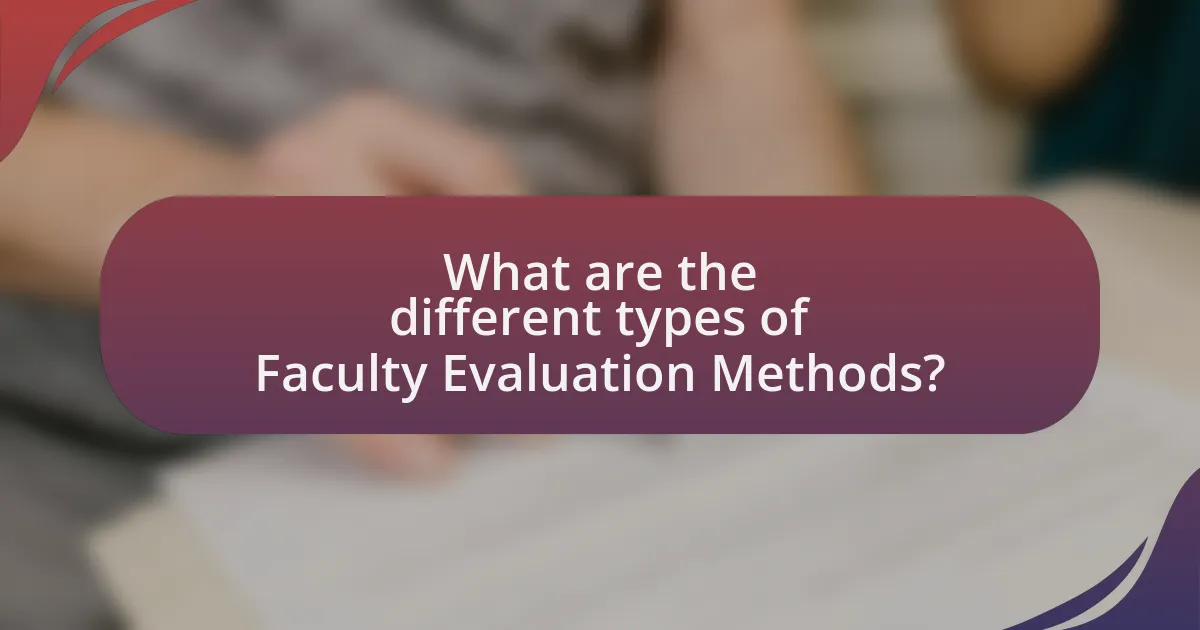
What are the different types of Faculty Evaluation Methods?
The different types of faculty evaluation methods include peer evaluations, student evaluations, self-assessments, and administrative evaluations. Peer evaluations involve colleagues assessing each other’s teaching effectiveness, providing insights based on shared experiences and standards. Student evaluations gather feedback from students regarding their learning experiences and the instructor’s teaching methods, often influencing faculty performance reviews. Self-assessments allow faculty members to reflect on their own teaching practices and professional development, fostering personal growth. Administrative evaluations are conducted by department heads or deans, focusing on faculty contributions to the institution’s goals and mission. Each method contributes to a comprehensive understanding of faculty performance and effectiveness in law schools.
How do peer evaluations contribute to faculty assessments?
Peer evaluations significantly enhance faculty assessments by providing a structured mechanism for colleagues to review and critique each other’s teaching effectiveness and scholarly contributions. This collaborative approach fosters a culture of accountability and continuous improvement among faculty members. Research indicates that peer evaluations can lead to more comprehensive assessments, as they incorporate diverse perspectives and expertise, which traditional student evaluations may lack. For instance, a study published in the Journal of Higher Education found that faculty members who participated in peer evaluations reported increased awareness of effective teaching practices and improved their instructional methods as a result.
What are the advantages of peer evaluations in law schools?
Peer evaluations in law schools enhance the educational experience by promoting collaborative learning and providing diverse perspectives on teaching effectiveness. These evaluations encourage faculty members to engage in constructive feedback, which can lead to improved teaching methods and curriculum development. Research indicates that peer evaluations foster a culture of accountability and professional growth among faculty, as they are more likely to reflect on their practices and make necessary adjustments based on peer insights. Additionally, studies show that peer evaluations can lead to increased job satisfaction and morale among faculty, as they feel supported by their colleagues in their teaching endeavors.
What challenges do peer evaluations present?
Peer evaluations present challenges such as bias, inconsistency, and lack of objectivity. Bias can arise from personal relationships or preconceived notions about colleagues, leading to skewed assessments. Inconsistency occurs when different evaluators apply varying standards, resulting in unequal evaluations. Lack of objectivity is often a concern, as evaluators may struggle to separate personal feelings from professional judgments. Research indicates that these challenges can undermine the reliability of peer evaluations, making it difficult to achieve fair and accurate assessments in academic settings, particularly in law schools where faculty performance is critical.
What role do student evaluations play in faculty assessments?
Student evaluations serve as a critical component in faculty assessments by providing direct feedback from learners regarding teaching effectiveness. These evaluations often influence decisions related to tenure, promotions, and overall faculty performance, as they reflect students’ perceptions of instructional quality and engagement. Research indicates that student evaluations can correlate with student learning outcomes, making them a valuable tool for assessing teaching effectiveness in law schools. For instance, a study published in the Journal of Legal Education found that faculty members who received higher student evaluation scores also demonstrated improved student performance on assessments, underscoring the significance of these evaluations in the faculty assessment process.
How reliable are student evaluations in measuring teaching effectiveness?
Student evaluations are generally considered to have limited reliability in measuring teaching effectiveness. Research indicates that these evaluations can be influenced by various factors unrelated to teaching quality, such as course difficulty, grading leniency, and student demographics. A study published in the “Journal of Educational Psychology” by Boring, Ottoboni, and Stark in 2016 found that student evaluations often reflect biases, particularly against female and minority instructors, which can distort the assessment of teaching effectiveness. Additionally, a meta-analysis in “Review of Educational Research” by Uttl, White, and Gonzalez in 2017 concluded that while student evaluations can provide some insights, they are not consistently reliable indicators of teaching quality.
What factors can bias student evaluations?
Student evaluations can be biased by several factors, including instructor characteristics, course content, and student demographics. Research indicates that gender and race of instructors can influence evaluations, with female and minority faculty often receiving lower ratings compared to their male and majority counterparts. Additionally, the perceived difficulty of the course can affect evaluations; students may rate easier courses more favorably regardless of teaching quality. Furthermore, students’ personal biases and expectations, shaped by their own backgrounds and experiences, can also skew their assessments. Studies have shown that these biases can lead to significant disparities in evaluation outcomes, impacting faculty assessments and career progression.
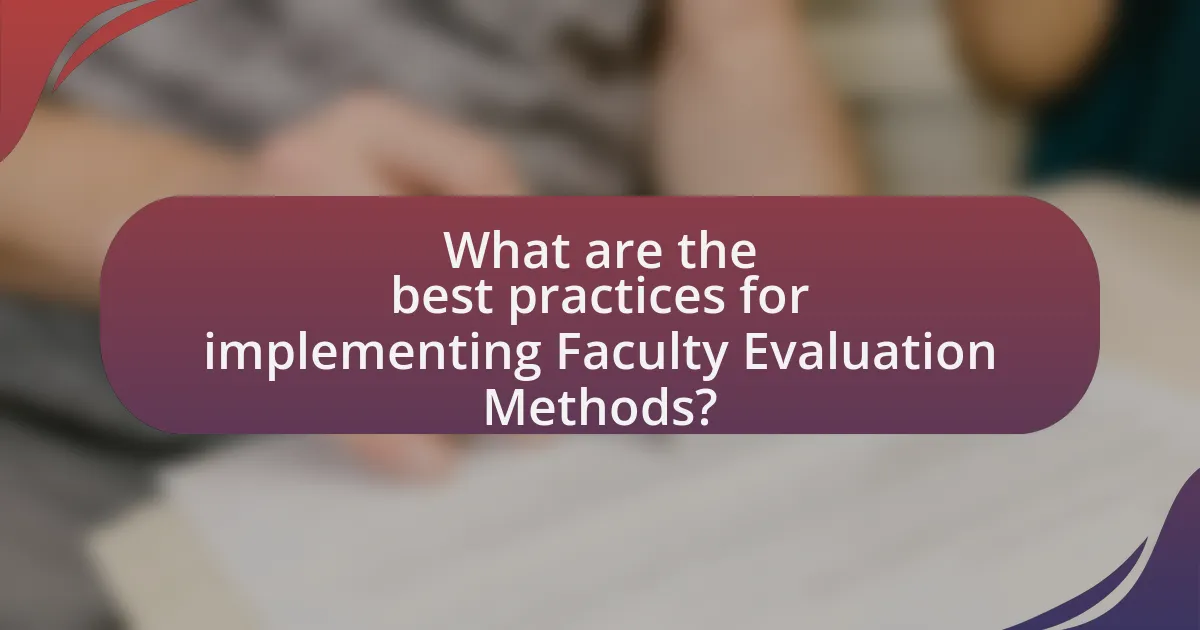
What are the best practices for implementing Faculty Evaluation Methods?
The best practices for implementing Faculty Evaluation Methods include establishing clear evaluation criteria, utilizing multiple assessment tools, ensuring transparency in the process, and providing constructive feedback. Clear evaluation criteria help faculty understand expectations and align their performance with institutional goals. Utilizing multiple assessment tools, such as peer reviews, student evaluations, and self-assessments, provides a comprehensive view of faculty performance. Transparency in the evaluation process fosters trust and encourages faculty engagement. Providing constructive feedback allows faculty to identify areas for improvement and enhances professional development. These practices are supported by research indicating that comprehensive evaluation methods lead to more accurate assessments and improved faculty performance.
How can law schools ensure fairness in faculty evaluations?
Law schools can ensure fairness in faculty evaluations by implementing standardized evaluation criteria and processes. Standardization minimizes bias by providing clear benchmarks for performance, which can include teaching effectiveness, research contributions, and service to the institution. Research indicates that structured evaluation systems, such as those incorporating peer reviews and student feedback, lead to more equitable assessments. For instance, a study published in the Journal of Higher Education found that faculty evaluations that utilized multiple sources of feedback resulted in a more balanced view of faculty performance, reducing the influence of individual biases.
What training is necessary for evaluators to conduct effective assessments?
Evaluators require training in assessment methodologies, legal education standards, and bias recognition to conduct effective assessments. This training equips evaluators with the skills to design valid evaluation criteria, understand the nuances of legal pedagogy, and mitigate personal biases that may affect their judgments. Research indicates that evaluators who undergo structured training programs demonstrate improved reliability and validity in their assessments, as evidenced by a study published in the Journal of Legal Education, which found that trained evaluators produced more consistent evaluations compared to their untrained counterparts.
How can law schools address biases in evaluation processes?
Law schools can address biases in evaluation processes by implementing standardized evaluation criteria and training evaluators on implicit bias. Standardized criteria ensure that all faculty members are assessed based on the same metrics, reducing subjective interpretations that can lead to bias. Training programs focused on implicit bias can help evaluators recognize their own biases and mitigate their impact on evaluations. Research indicates that structured evaluations can lead to more equitable outcomes, as evidenced by studies showing that standardized assessments reduce disparities in grading and promotion decisions among diverse faculty members.
What are common pitfalls in Faculty Evaluation Methods?
Common pitfalls in faculty evaluation methods include reliance on subjective criteria, inadequate feedback mechanisms, and insufficient consideration of diverse teaching styles. Subjective criteria can lead to biased evaluations, as personal opinions may overshadow objective measures of performance. Inadequate feedback mechanisms often result in a lack of actionable insights for faculty improvement, hindering professional development. Additionally, insufficient consideration of diverse teaching styles fails to recognize the varied approaches that can effectively engage students, ultimately impacting the evaluation’s fairness and accuracy. These pitfalls can undermine the integrity of the evaluation process and affect faculty morale and performance.
How can law schools avoid over-reliance on quantitative metrics?
Law schools can avoid over-reliance on quantitative metrics by implementing a holistic evaluation approach that incorporates qualitative assessments alongside numerical data. This method allows for a more comprehensive understanding of faculty performance, emphasizing teaching effectiveness, student engagement, and contributions to the academic community. Research indicates that qualitative feedback, such as peer reviews and student evaluations, can provide valuable insights that numbers alone may overlook, thus fostering a more balanced evaluation system. By prioritizing diverse evaluation methods, law schools can ensure that faculty contributions are assessed in a multifaceted manner, ultimately enhancing educational quality and institutional integrity.
What strategies can be employed to improve the evaluation process?
To improve the evaluation process in law schools, implementing a multi-faceted approach that includes peer evaluations, student feedback, and self-assessment is essential. Peer evaluations allow faculty members to receive constructive criticism from colleagues, enhancing teaching methods and course content. Student feedback provides insights into the effectiveness of teaching from the learner’s perspective, which can be quantitatively measured through surveys and qualitative feedback. Self-assessment encourages faculty to reflect on their teaching practices and identify areas for improvement. Research indicates that combining these strategies leads to a more comprehensive evaluation process, fostering continuous improvement in teaching quality and student outcomes.
What practical tips can enhance Faculty Evaluation Methods in Law Schools?
To enhance Faculty Evaluation Methods in Law Schools, implementing a multi-faceted evaluation approach is essential. This includes incorporating student feedback, peer reviews, and self-assessments to provide a comprehensive view of faculty performance. Research indicates that using diverse evaluation metrics leads to more accurate assessments, as evidenced by a study published in the Journal of Legal Education, which found that schools employing multiple evaluation methods reported higher satisfaction among faculty and students. Additionally, regular training for evaluators on best practices in assessment can improve the quality and fairness of evaluations, ensuring that they are aligned with institutional goals and standards.
